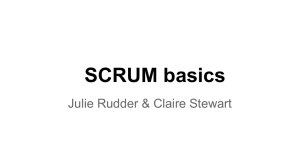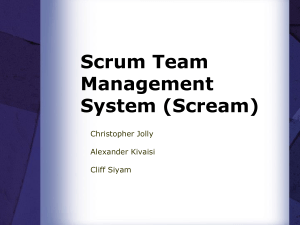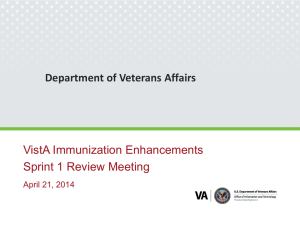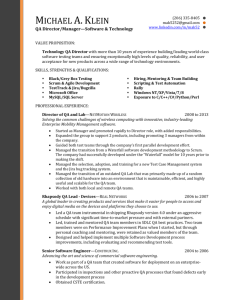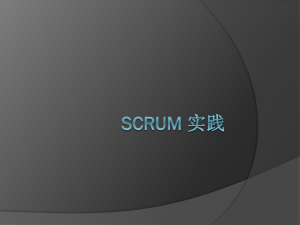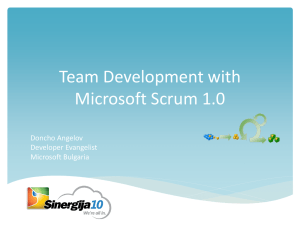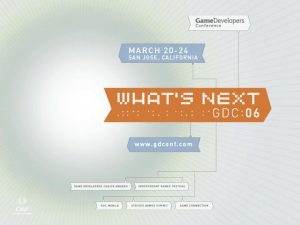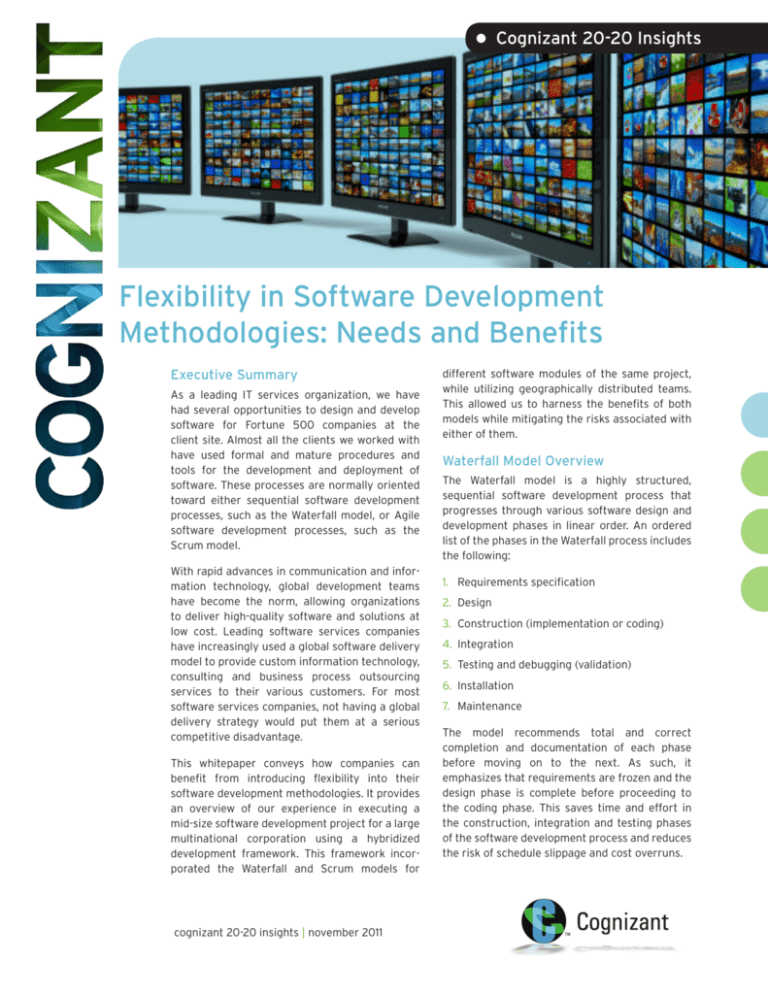
• Cognizant 20-20 Insights
Flexibility in Software Development
Methodologies: Needs and Benefits
Executive Summary
As a leading IT services organization, we have
had several opportunities to design and develop
software for Fortune 500 companies at the
client site. Almost all the clients we worked with
have used formal and mature procedures and
tools for the development and deployment of
software. These processes are normally oriented
toward either sequential software development
processes, such as the Waterfall model, or Agile
software development processes, such as the
Scrum model.
With rapid advances in communication and information technology, global development teams
have become the norm, allowing organizations
to deliver high-quality software and solutions at
low cost. Leading software services companies
have increasingly used a global software delivery
model to provide custom information technology,
consulting and business process outsourcing
services to their various customers. For most
software services companies, not having a global
delivery strategy would put them at a serious
competitive disadvantage.
This whitepaper conveys how companies can
benefit from introducing flexibility into their
software development methodologies. It provides
an overview of our experience in executing a
mid-size software development project for a large
multinational corporation using a hybridized
development framework. This framework incorporated the Waterfall and Scrum models for
cognizant 20-20 insights | november 2011
different software modules of the same project,
while utilizing geographically distributed teams.
This allowed us to harness the benefits of both
models while mitigating the risks associated with
either of them.
Waterfall Model Overview
The Waterfall model is a highly structured,
sequential software development process that
progresses through various software design and
development phases in linear order. An ordered
list of the phases in the Waterfall process includes
the following:
1. Requirements specification
2. Design
3. Construction (implementation or coding)
4. Integration
5. Testing and debugging (validation)
6. Installation
7. Maintenance
The model recommends total and correct
completion and documentation of each phase
before moving on to the next. As such, it
emphasizes that requirements are frozen and the
design phase is complete before proceeding to
the coding phase. This saves time and effort in
the construction, integration and testing phases
of the software development process and reduces
the risk of schedule slippage and cost overruns.
Progress on the project can be easily monitored
by interested stakeholders because each phase
has a defined start and end point. Significant
customer involvement is required during the
requirements specification, design and testing
phases, while remaining phases do not require
significant input from the customer. One major
drawback associated with the Waterfall model is
that it can be too late in the development cycle
to discover business critical defects, as business
testing only begins after the development phase.
Scrum Development Process Overview
Scrum has proved to be a highly successful
framework for project management that takes
an adaptive, iterative and incremental approach
toward software and product development.
Scrum is ideally suited for projects with changing
requirements. In order to operate in such an
environment, Scrum relies on a self-organizing,
self-managing, cross-functional Scrum team that
is supported by a Scrum Master and a product
owner. The product owner represents the voice
of the users and customers and is responsible for
creating a prioritized wish list of product features,
called a product backlog.
Scrum projects advance via a series of sprints,
which are typically two to four weeks long. At
the start of the sprint, team members commit
to completing a portion of the product backlog.
This set of requirements in the backlog is frozen
for the duration of the sprint. During each sprint,
the Scrum team works on creating a potentially
deliverable product increment. At the end of the
sprint, the product owner and the customers
review the deliverable and provide feedback on
the build. This feedback could take the form of
bugs, changes in functionality, etc., which could
significantly alter the product backlog and the
work done in the next sprint.
Although the Scrum methodology often requires
significant customer involvement throughout
the software development process, it can significantly increase productivity and reduce the
time required to release quality software to the
customer — when it is used to solve the right
problems, by capable teams and with supportive
management.
Project Description
Respirator Medical Analysis Software (RMAS)
is an application that generates and maintains
respirator evaluations for 40,000 workers around
the world in a Fortune 100 product manufacturing
conglomerate. It collects exhaustive health-related information from workers assigned to manufacturing facilities and stores this information in a
database. Based on responses from the workers,
the application uses a complex algorithm to
approve the right respirator for the workers.
Scrum Process Overview
Scrum Master
Input from End-Users,
Customers, Team and
Other Stakeholders
Product
Backlog
Refinement
Daily Scrum
Meeting and
Artifacts Update
Sprint
Product Owner
1
2
3
4
5
6
7
8
9
10
11
12
13
es
tur es
Feeaatur
F
1-4 Weeks
Team
Team Selects
How Much to
Commit to do
by Sprint’s End
Sprint Planning
Meeting
(Parts 1 and 2)
Review
ks
Tas
No Changes
Sprint
Backlog
in Duration or Goal
Product
Backlog
Potentially
Shippable Product
Increment
Retrospective
Figure 1
cognizant 20-20 insights
2
Functionality contained in the algorithm is based
on government regulations and helps the client
create a safe working environment in its manufacturing plants. It allows the client to manage
risks associated with corporate liability, while
embracing its role as a responsible corporate
citizen.
The project has been developed as a three-tiered
Web application on the Java Enterprise Edition
platform, consisting of presentation, business and
data layers. The application supports five different
actors and contains 22 screens, with functionality that is based on requirements contained in 26
use cases.
The algorithm to evaluate the correct respirator
for a worker formed the core of the business
functionality and accounted for nine of the 26 test
cases. Since the algorithm was based on regulations that had not changed for a number of years,
requirements for the business tier were very
well defined and fairly stable when the project
kicked off.
The remaining 17 test cases dealt mostly with the
presentation layer and covered complex functionalities involving the actors and user interface
screens. The requirements for these 17 test cases
were initially undefined by the client and were to
be elaborated on as the project progressed.
Project Implementation
As project requirements and use cases were
analyzed, we decided that software development of the business functionality would be best
executed under a traditional Waterfall model,
while using the Scrum model for the presentation
layer would allow us to rapidly develop against
emerging user interface requirements. A hybrid
Waterfall and Scrum approach seemed to be
a feasible and sensible option for a number of
reasons:
• Requirements of the business and data functionality were stable and clearly defined.
• Clients
saw greater business benefits in
validating and testing the algorithm in its
entirety, as opposed to validating incremental
iterations of business functionality.
• Software
design and development of the
algorithm needed to be precisely documented
and delivered to the client.
• It was possible to deliver the business functionality to the client independent of a produc-
cognizant 20-20 insights
tion-level user interface, thus allowing error
detection and bug fixing before completing
the development of the presentation layer.
This flexibility somewhat mitigated the risk of
delivering incomplete software at the end of
development.
• Requirements
pertaining to the presentation layer were going to be developed as the
project progressed.
• Clients
aimed to lessen the burden of data
collection on workers and needed to see
working prototypes of several user interface
options before deciding on the most userfriendly and least time-consuming option.
Implementation of the Business
and Data Layers
Besides the stability of client requirements, the
success of a project or module executed by a
global team using the Waterfall model depends
on the offshore development team’s understanding of the requirements. To
ensure all stakeholders were
We decided
on the same page, a Cognizant
associate was assigned to the business
work on-site at the client functionality would
location as a business and IT
be best executed
analyst.
under the Waterfall
The primary responsibility of
model, while the
the analyst was to work closely
with client business users to Scrum model
develop and refine use cases was best for the
for the business module. This
presentation layer.
activity was scheduled to be
completed in three weeks. The
use cases were loaded into Rational RequisitePro
to ease management and versioning. The relationships between the use cases and the high-level
requirements were maintained through a requirements traceability matrix (RTM).
Once the high-level requirements were framed
and the use cases were written, the use cases
were sent to the development team for analysis,
clarification and validation. Although it was
estimated to be a weeklong activity, clarifications
were sought until design and estimates were
complete.
As a next step, the effort to develop the core
business functionality was analyzed and the
estimates were created using the Use Case Point
Estimation methodology. Both the development
team and the IT analyst were involved at this
3
stage. The estimation formulation and review
were completed in two weeks. The estimates were
reviewed with clients, and client approval was
obtained. Once the estimates were approved, the
requirements were frozen.
Following approvals, the analyst then worked with
the offshore team lead and senior developers to
develop the software design. The design phase
included both the database design, as well as
the architecture design. The design specifications and design diagrams were documented in a
Software Architecture Document (SAD) template
and were reviewed by the IT analyst. It was then
reviewed by a client architect, and the design was
approved. The design process
Scrum project was completed in three weeks.
For a
to succeed, it is
crucial to foster
a collaborative,
self-organizing
and self-managing
environment within
the team.
Based on the final approved
design, the development team
started to develop the business
module. The application development was completed in 2.5
months, including unit testing
of different pieces of the
functionality and peer testing
within the team.
The business module was then delivered for
quality assurance to the testing team. Testing,
including bug fixing, was completed in two weeks,
and the final build was delivered to the client for
user acceptance testing and business scenario
testing. Any changes to the functionality or
requirements were logged and implemented,
using the complete Waterfall model template in a
new, smaller iteration.
a portion of its non-work hours to brainstorming
and consulting with each other as needed. We
also provided team members with virtual private
network (VPN) and remote desktop access so they
could connect to their work machines without
needing to be in the office. Phone and videoconferencing facilities were provided to enable interactive dialogue and the perception of nonverbal
communication signals.
For the purposes of UI development, the onsite
analyst assumed the role of product owner. Given
his proximity to client management and his
involvement in use case and requirements development, this was a logical choice. The offshore
team was made up of the Scrum Master and the
actual development team.
The requirements that were generated in the
backlog were developed across different sprints.
Each sprint had a timeline of one month, with two
sprints executed by two different Scrum teams in
parallel. The sprints executed in parallel consisted
of requirements that were independent modules
and hence did not require integration at the end
of the month. The UI module was completed in
a two-month timeframe, utilizing four different
sprints.
Each sprint was executed in the following
manner:
• To ensure that project business requirements
were clearly communicated and understood by
the offshore team, the product owner and the
offshore team worked together on converting
the business requirements of the prioritized
product backlog into IT requirements.
Implementation of Scrum
• The first four days after the sprint planning
For a Scrum project to succeed, it is crucial to
foster a collaborative, self-organizing and selfmanaging environment within the team. Development of trust between team members is a primary
ingredient for the creation of such an environment. It is, therefore, essential for teammates
to communicate as openly and regularly as
required.
• In
In a geographically distributed team, it is often
necessary to spend time collaborating with team
members outside of core work hours in order
to bridge the time difference between onsite
and offshore locations. We, therefore, set team
member expectations accordingly before the start
of the project and were fortunate to have a highly
skilled and enthusiastic team willing to dedicate
• A
cognizant 20-20 insights
meeting within every month-long sprint was
devoted to this process, enabling the offshore
team and the onsite analyst to be on the same
page.
addition to brainstorming sessions, daily
20-minute standup video/teleconference calls
were scheduled to discuss what work was
completed, what remained and to discuss any
potential problems, as well as provide clarifications on requirements and requested features.
An important tool was the creation of meeting
minutes.
shared Excel spreadsheet was used to
exchange queries and clarifications on
requirements in the backlog between the
Scrum team and Scrum product owner. While
4
A Hybrid Development Framework
The implementation was done in sprints of two per
month with a feedback phase and at the end of each sprint.
The implementation was done as a
single flow for four months.
Sprint
Waterfall
Implementation
Sprint Review and Feedback
Sprint
Sprint Review and Feedback
Sprint
Sprint
Sprint
Figure 2
it can be argued that Agile development is
less about creating documentation and more
about development of working software, it is
important in a global context to document and
validate the understanding of the entire team.
During development, pair programming was
used to effectively share responsibilities in the
project. Instead of assigning delivery and unit
testing of an entire requirement to one team
member, the responsibility is shared by two
team members, with development and unit
testing occurring in tandem.
• The last week of each sprint was devoted to
peer testing and bug fixing.
• A sprint review meeting was held after each
sprint to gather feedback from the product
owner and the clients. Any changes suggested
during this meeting were added to the product
backlog and prioritized by the product owner
for the next sprint.
Conclusion
We successfully developed and tested the presentation and business modules within six months,
as per client requirements, and delivered an
integrated application for user acceptance testing.
Deployment was scheduled after completion of
UAT and a few final bug fixes. The client considered
the deployment a great success, and we heard
a lot of positive feedback from the RMAS user
cognizant 20-20 insights
base and the client project manager. Thus, the
hybridized software development approach was a
novel and highly effective solution, used to guide
a challenging project to an extremely favorable
outcome.
Having a focused and expert IT team that was
comfortable with different software development
models — as well as taking an open and flexible
approach toward the software development
process — were the key ingredients to speeding
up development time and minimizing risks. At the
same time, the global software development team
allowed us to keep costs low and helped our client
meet budget targets.
While a hybrid software development process
may not be a silver bullet for all software development problems, it could be detrimental for
large organizations to be biased toward a single
software development methodology to execute
all projects. The choice between Agile, Waterfall
or any other software development methodology
should be based on which model best reduces
risk, increases productivity and improves quality
while achieving the goals of the project.
We believe that the freedom afforded to software
architects, analysts or developers to tailor the
software development process according to
business needs and project characteristics is a
crucial factor in successful project completion.
5
References
http://shannonxj.blogspot.com/2008/01/waterfall-model.html
http://idimension.wordpress.com/tag/the-scrum-master/
http://java.sun.com/javaee/
http://www-01.ibm.com/software/awdtools/reqpro/
www.mountaingoatsoftware.com/topics/scrum
About the Author
Siddharth Sharad Chandak is a Project Manager at Cognizant. He manages a number of critical projects
that Cognizant is currently executing for a key customer in the manufacturing and logistics vertical.
He holds a Master of Science degree in Computer Science from Kansas State University. His interests
include architecting and designing enterprise software applications, software performance tuning and
project management. He can be reached at siddharth.chandak@cognizant.com.
Vishnu Rangarajan is a Senior Associate at Cognizant. He manages and supports multiple projects for
key clients for Cognizant in the manufacturing and logistics vertical. He holds a Bachelor of Engineering degree in Electrical and Electronics from SRM Engineering College in India. His interests include
database administration and project management. He can be reached at varadhavishnu.rangarajan@
cognizant.com.
About Cognizant
Cognizant (NASDAQ: CTSH) is a leading provider of information technology, consulting, and business process outsourcing services, dedicated to helping the world’s leading companies build stronger businesses. Headquartered in
Teaneck, New Jersey (U.S.), Cognizant combines a passion for client satisfaction, technology innovation, deep industry
and business process expertise, and a global, collaborative workforce that embodies the future of work. With over 50
delivery centers worldwide and approximately 130,000 employees as of September 30, 2011, Cognizant is a member of
the NASDAQ-100, the S&P 500, the Forbes Global 2000, and the Fortune 500 and is ranked among the top performing
and fastest growing companies in the world. Visit us online at www.cognizant.com or follow us on Twitter: Cognizant.
World Headquarters
European Headquarters
India Operations Headquarters
500 Frank W. Burr Blvd.
Teaneck, NJ 07666 USA
Phone: +1 201 801 0233
Fax: +1 201 801 0243
Toll Free: +1 888 937 3277
Email: inquiry@cognizant.com
1 Kingdom Street
Paddington Central
London W2 6BD
Phone: +44 (0) 20 7297 7600
Fax: +44 (0) 20 7121 0102
Email: infouk@cognizant.com
#5/535, Old Mahabalipuram Road
Okkiyam Pettai, Thoraipakkam
Chennai, 600 096 India
Phone: +91 (0) 44 4209 6000
Fax: +91 (0) 44 4209 6060
Email: inquiryindia@cognizant.com
­­© Copyright 2011, Cognizant. All rights reserved. No part of this document may be reproduced, stored in a retrieval system, transmitted in any form or by any
means, electronic, mechanical, photocopying, recording, or otherwise, without the express written permission from Cognizant. The information contained herein is
subject to change without notice. All other trademarks mentioned herein are the property of their respective owners.



